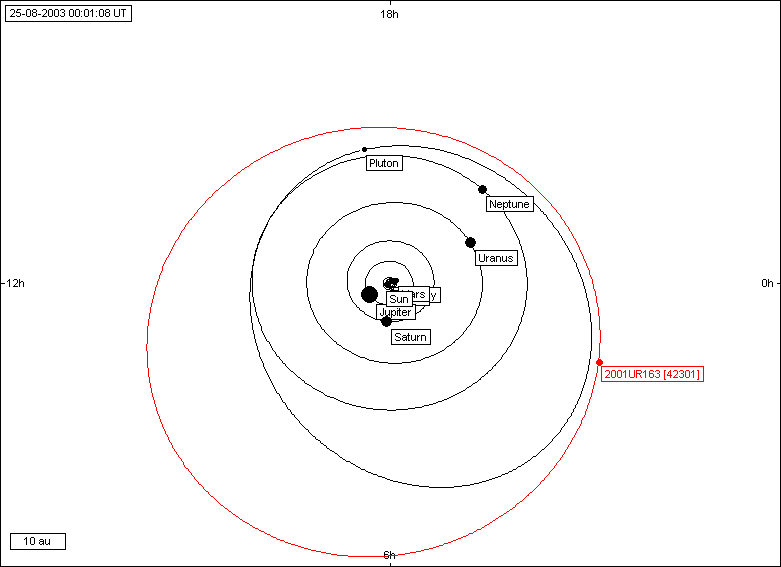
Solar system view : 2001UR163 path
Trans neptunian object (TNO) 2001UR163
During this observing run, a successful attempt was achieved to record a TNO object. Most of these objects are fainter than magnitude 20, this is a real challenge for amateurs. We have tried 2001QX322: this object was not detected, because it was probably too faint to be recorded. The TNO called 2001UR163 was successfully detected, by the means of 1000s exposures. The object's Signal to Noise (SNR) ratio was around 6 per 0.63" pixel field of view, and the limiting magnitude at SNR=3 is around Mg 22.3 - The seeing, at that level, has an important impact : compare the detection capabilities between picture 1 and 3 : the levbel of atmospheric turbulence pushed me to increase the exposure time to compensate the detection degradation. Astrometric measurements were not so obvious, particularly with the 3rd picture, where I have to use barycentric algorithm to fin out the object position instead of normal gaussian centroid.

Solar system view : 2001UR163 path
All images where recorded using 600mm telescope, F=2240mm, Sbig ST10 MXE camera, no filter, scale is 0.63" per pixel.

Picture 1 : August 25th 2003 - 01h39m53s, 1080s (multiple 240s exposure stacked)
Seeing = 2.9"
TNO's Magnitude : 20.9 +/-0.1 (total object signal : 5402 ADUs, rms sky background
noise : 70ADU)
01h25m24.770s +09°46'47.98''

Picture 2 : August 27th 2003 - 01h34m19s, 960s (multiple 240s exposure stacked)
Seeing = 3.2" TNO's Magnitude : 20.7 +/-0.1 (total object signal : 7427
ADUs, rms sky background noise : 57 ADU)
01h25m20.20s +09°46'22.80"

Picture 3 : August 30th 2003 - 01h38m36s, 2160s (multiple 240s exposure stacked)
Seeing = 3.8" TNO's Magnitude : 21.1 +/-0.1 (total object signal : 11200
ADUs, rms sky background noise : 87 Adu)
01h25m12.88s +09°45'41.9"
The object magnitude has slightly changed in the course of the 5 days, nevertheless,
given the measurements uncertainty, I' am not sure whether or not this is actual..Increasing
the exposure time would have lead to problems, because the object is moving
(slowly, but at a rate of 1" per hour). To circumvent this problem, a special
shift and stack, using the object motion (PA, and speed) could have been applied
to avoid the object to get blurred on the final image, such algorithm exists
already, and could be implemented easly.
Observing TNO's (Kuiper's belt objects) is not an easy task.. though, it worth trying to use a smaller telescope such as a 300mm.
Measurements sent to MPC :
2001UR163 C2003 08 25.06937 01 25 24.77 +09 46 48.0 20.70R 184
2001UR163 C2003 08 27.06550 01 25 20.20 +09 46 22.8 20.90R 184
2001UR163 C2003 08 30.06847 01 25 12.88 +09 45 41.9 21.10R 184
References